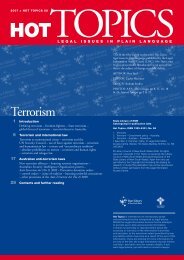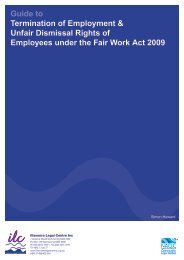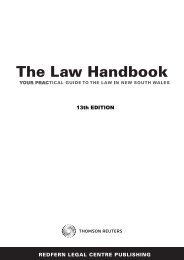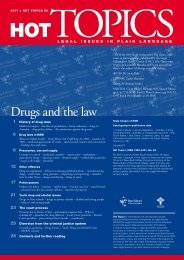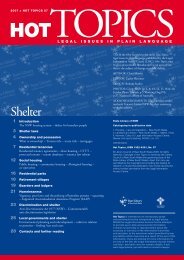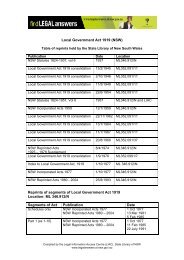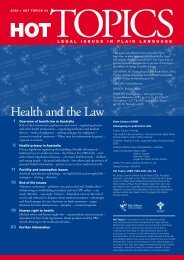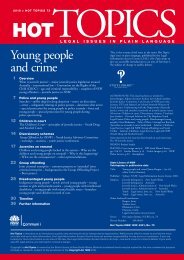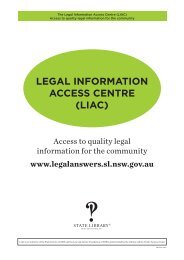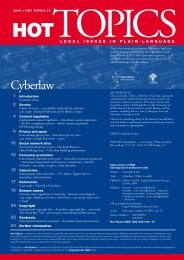Aboriginal people and the law - Legal Information Access Centre
Aboriginal people and the law - Legal Information Access Centre
Aboriginal people and the law - Legal Information Access Centre
You also want an ePaper? Increase the reach of your titles
YUMPU automatically turns print PDFs into web optimized ePapers that Google loves.
2 <strong>Aboriginal</strong> <strong>people</strong> <strong>and</strong> <strong>the</strong> <strong>law</strong> 47Rates of arrest <strong>and</strong> imprisonmentAlthough <strong>the</strong> Royal Commission into <strong>Aboriginal</strong> Deaths inCustody recommended that police seek to avoid arrestingIndigenous <strong>people</strong> wherever possible (Recommendation87), <strong>the</strong> arrest rate for Indigenous <strong>people</strong> remainsdisproportionately high.Similarly, <strong>the</strong> rate of imprisonment remains disproportionatelyhigh, even though <strong>the</strong> key recommendations of<strong>the</strong> royal commission were directed at reducing <strong>the</strong>over-representation of Indigenous <strong>people</strong> in jails, <strong>and</strong>certain safeguards have been put in place for Indigenous<strong>people</strong> (see Circle sentencing at [2.220]).[2.150] Limitations on policepowersThere are specific limitations on police powersto arrest, detain, search or issue directionsin relation to both Indigenous <strong>and</strong>non-Indigenous <strong>people</strong>:• An <strong>Aboriginal</strong> person who has beenarrested can be detained for questioningfor up to two hours. This may be extendedto eight hours, with a magistrate’sapproval, if <strong>the</strong> offence being investigatedis punishable by imprisonment for morethan 12 months.• The investigating police must notify an<strong>Aboriginal</strong> legal aid organisation whenan <strong>Aboriginal</strong> person is arrested. Theperson is entitled to have a legal practitionerpresent to give advice duringquestioning.• If <strong>the</strong> person is arrested more than oncein 48 hours, <strong>the</strong> investigation period foreach arrest is reduced by <strong>the</strong> period of <strong>the</strong>previous investigations.• At <strong>the</strong> end of <strong>the</strong> investigation period <strong>the</strong>person under arrest must be released,ei<strong>the</strong>r unconditionally or on bail, orbrought before a magistrate as soon aspracticable.• A person who has not been arrested maynot be detained against <strong>the</strong>ir will.• The person being investigated must becautioned, in a language in which <strong>the</strong>ycan communicate with “reasonablefluency”, that <strong>the</strong>y do not have to sayanything during questioning. In somecircumstances an interpreter is needed.The person must be told of <strong>the</strong>ir right tocommunicate with a friend, relative or<strong>law</strong>yer, <strong>and</strong> be allowed to do so. Ifpracticable, <strong>the</strong> caution should berecorded.• An <strong>Aboriginal</strong> person under arrest isentitled to have a friend or supportperson present during questioning.Investigating police do not have to notify an<strong>Aboriginal</strong> legal aid organisation or permit afriend to be present if <strong>the</strong> detainee’s education<strong>and</strong> underst<strong>and</strong>ing means <strong>the</strong>y are notat a disadvantage.Police questioning before arrestPrior to arrest, police officers have <strong>the</strong> powerto dem<strong>and</strong> <strong>the</strong> name <strong>and</strong> address of anyperson:• in relation to certain motor traffic <strong>and</strong>drug offences• where <strong>the</strong> police hold a reasonable suspicionthat <strong>the</strong> person:– was a witness to a crime– has stolen goods in <strong>the</strong>ir car– has a dangerous implement, or– possesses or is consuming alcohol in apublic place.There are no special provisions in <strong>the</strong> NSWCrimes Act 1914 or Evidence Act 1995 requiring<strong>Aboriginal</strong> <strong>people</strong> under arrest to betreated any differently when being interrogatedby police.[2.160] Forensic proceduresFollowing <strong>the</strong> introduction of <strong>the</strong> Crimes(Forensic Procedures) Act 2000 (NSW), <strong>the</strong>reare clear rules as to how police may obtainbodily samples for forensic purposes.A distinction is made between intimate<strong>and</strong> non-intimate procedures.Non-intimate proceduresA non-intimate sample might consist of:• fingerprints• hair• nail scrapings• body moulds• photographs (s 3(1)).A non-intimate procedure can be carried outunder an order from a senior police officer(Crimes (Forensic Procedures) Act 2000, s 17).



